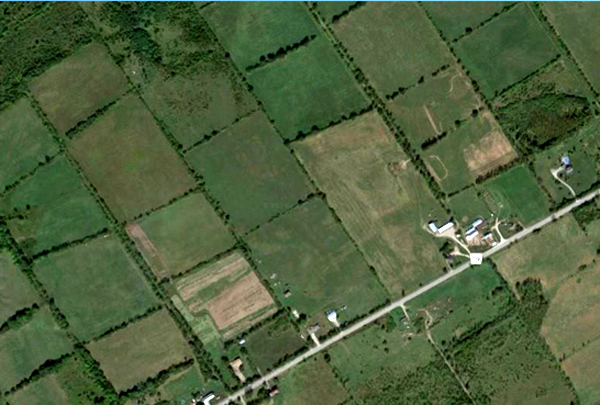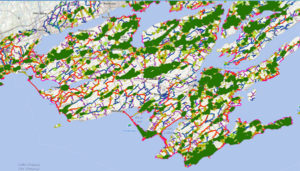Citizens concerned removing hedgerows is destroying County’s natural protectors
Sue Capon | May 24, 2018 | Comments 14
 Two Ameliasburgh residents concerned about the practice of removing tree lines and hedgerows are asking the municipality to consider ways to better conserve the County’s natural protectors.
Two Ameliasburgh residents concerned about the practice of removing tree lines and hedgerows are asking the municipality to consider ways to better conserve the County’s natural protectors.
Elizabeth Blomme and Bill Bonter told committee of the whole members Thursday they have found documentation of serious effects on the environment, however unintended, when the hedgerows are removed.
“Historically, small-scale farming in the County created a patchwork of fields demarcated by hedgerows,” said Bonter in the presentation. “In recent decades, the County’s agricultural landscape has changed, sometimes dramatically, as hedgerows are removed to create much larger, continuous fields.”
The two maintain the elimination of the pastoral mainstays is taking place without consideration of longer-term consequences.
They requested council “assist in determining the extent of the damages being done by this practise and take appropriate action to prevent further damage.”
They noted other jurisdictions that saw hedgerows eliminated are now painstakingly re-planting them at substantial cost.
“Hedgerows (windbreaks, shelterbelts, fencelines) are regarded as critical components of medium-and-long-term solutions to ensuring economic, environmental and agricultural sustainability in rural regions,” said Bonter.
He noted they combat soil erosion; wind and crop damage; mitigate drought and flooding; connect wildlife habitats and also contribute to road safety by blocking blowing snow and dust.
“Removal of the County’s hedgerows severs vital arteries that connect and nourish our woodlands,” he said. “Without these natural corridors for large and small wildlife, pollinators and insects, the diversity of our natural habitats will decline – alarming reductions in our bird populations are already occurring. Over time, the quality of the land and soil will degrade.”

The Neighbouring Communities Working Group mapped the County’s natural heritage features in 2011 as part of a project to propose an inter-connected natural heritage system for the region. Hedgerows are shown as purple lines. Blomme and Bonter suggest the map be updated.
Bonter added that the Ontario Ministry of Agriculture, Food and Rural Affairs supports the establishment and maintenance of hedgerows, citing studies where benefits included improvements in crop yields, pollination, wind damage reductions in orchards and livestock survival rates.
Prince Edward Island, he noted, has a Hedgerow Planting Program that subsidizes and provides plants and seedlings for new hedgerows; while Alberta’s ministry of agriculture research improved crop yields compensate for reduced planing areas, particularly in dry years.
Blomme said ongoing deliberations on the County’s official plan offer the ideal opportunity to safeguard and ensure the role of hedgerows as natural corridors is sustained.
“We propose that citizens, the agricultural community, environmental groups and relevant stakeholders work with the County to design and implement a sustainable solution where there is still time.”
Councillor Gord Fox suggested input from farmers is essential to both problems and solutions.
“It’s importance to have a balance between our agriculture and ecological futures,” said councillor Bill Roberts.
Roberts requested a staff report on the moderation of hedgerows and tree line removal in the County and recommendations related to the natural history strategy in the County’s official plan. He requested input from the agricultural committee, Quinte Conservation and the National Farmers’ Union, taking into account modern farming practices and trends in the County, its varied topography, field size and agricultural and wildlife ecosystems.
Filed Under: Local News
About the Author:































I am seeing that regardless of the implementations alot of these rapped lines there is flooding in most fields with heavy rains and nothing there to help suck up, drink the excess water that will not drain now. There is a good reason that the tree lines where left there meaning moons ago by our forefathers and the new way of farming has totalu abandoned that. My Poppy God rest his soul told me they are there to help in the drainage and if they are taken out the soil will just wash away and there wildlife in them Chrissy. I don’t like being in bloomfield and seeing my neighbour over there on county road 4. They really weren’t my neighbour before but they are now because I can see them. At first I thought that the tree lines were just being thinned out because they were getting a bit over barring.
i agree john my dad farmed for many years here it became necessary to make those 5 and 10 acre fields larger by removing fence rows over the years farm equip. became larger and needed acres to survive were needed there is much farm land going for housing these days and so a lot of fence rows and treed areas are being removed look around picton to see this
This is not an issue that can be reduced to simple statements such as the majority that are given here.
Certainly, there is room for some well-placed windbreaks and shelter belts.
However, ever since Magna Carta, there is legal protection for landowners from overbearing government and intrusive regulation, a law which stands today.
This was recently reinforced by Lynch v. St. John’s, 2016.
Therein, the justice ruled that if society receives the benefit from a legally compelled service (expropriation), it also pays for that benefit.
I think everyone would agree with the concept of payment for services rendered.
As an aside, it would be interesting to see the reaction if “our” urban areas would be compelled to return a percentage of their areas to natural environment. Like maybe about 1 in 10 or 15 of “our” houses bulldozed and returned to trees. You know, just to keep everything fair…
Mark, you can add habitat for numerous native bee species to the list of wildlife that benefits from hedgerows. Surely farmers are concerned about maintaining bee habitat? As well, they act as filters cleaning water runoff and also prevent soils containing fertilizers from blowing into water bodies and promoting algae growth. The Ministry of Agriculture, Food and Rural Affairs includes “buffer strips” (or hedgerows) as part of their best management practices. As “stewards of the land” I’d be interested in knowing what the OFA’s position is on this issue. I could find nothing on their website.
With no hedge rows wildlife have no routes of safety from the woodlots. They move out. Birds have no habitat. No wind breaks and severe conditions in storms and worsens drought conditions. It is a poor practice in so many ways.
Why not try an incentive instead of more regulations dictating how someone can use their land? The carrot always works better than the stick as proven by conservation incentive programs world wide.
The County has an early 1900’s incentive program to thank for its maple lined county roads. Land owners were paid per tree they planted. It was a very successful program that we still benefit from a hundred years later.
With the evolution to bigger equipment due to cost of diesel, part time farming and contracting out, small fields just don’t work out economically or efficiently. Build an incentive program that offsets the extra costs/labour, then you might just have some volunteers.
Farmers aren’t the villain here. They do more for Woodlot and grassland conservation than any other member of the general population. They are pushed to maximize efficiencies to pay the bills. In the end, the county has lost more trees to housing development than any other sector. Perhaps picton should look into building up and not out into our “heritage” hedgerows.
During the winter, the trip between Picton and Northport can be a hazardous one because of the removal of hedgerows. I know other areas have it just as bad. This past winter, during mid day, the snow was blowing so badly around the intersection of Cty. Rd. 4 and Fry Road the visibility was non existent – both a car and a town snow plow had gone off the road.
My question – What is the set back distance off county roads does the municipality own? Perhaps they can encourage tree and bush growth within those set backs that can help solve the problem of stripping the land of vegetation??
If there is no desire from landowners to stop this destructive practice it can be legislated. And for very good reasons in protecting the environment and all creatures on the earth .
Barren wasteland. Destructive practices. Do you guys like to eat? Ever buy imported food? Good luck trying to tell farmers in California or Florida how to conduct their business. Wow!
This is quickly going to get to a “who owns the land and pays property tax” position. In other areas of Ontario this chatter has lead to a mass de-forestation effort by landowners and farmers, to get it done prior to more restriction. Better to use a carrot to prevent more tree removal, figure out a way to incentive leaving trees rather than restricting removal. And, some of the species in the fence bottoms are also on the noxious species list that the municipality requires removal by the landowner, so not quite so simple. A half way measure is a delineation between “cross fence bottoms” rather than “line fence bottoms”, still have large fields but not necessarily 300 acres or more with no treelines. County road 2 has been a barren wasteland for 40 years or more already, this is not a new concept. The research about crop yields is sketchy since the impact of wind and erosion is totally dependent on how the dirt was left in the fall, and what is being grown, coupled with drought or not. You will not convince a single farmer to leave fence bottoms with that data.
Is this some kind of joke? No tax relief on one hand, and then tell farmers to keep their fields smaller and smaller with creeping -in fence rows?
The people who spoke to Council are quoting 20 year old data that does not account for no-till farming,which has done more for erosion of all types than trees every 400 metres ever will.
Wild life do not contribute to a farmers bottom line. They are a nuisance.
You want to preserve wildlife, Mr Bonter? Then step up and buy 1000 acres of prime farmland and plant it all to trees.
Put your money up. Lead the way. Show us how it’s done!
Cty. Rd. 4 just outside of Picton is a glaring example of this destructive practice.
I agree with the concerns, and the need for remediation. A good example of what happens without hedgerows is Belleville Road. In winter, every time the wind blows, it’s dangerous to drive.
Re “alarming reductions in our bird populations”, I’d like to see some statistics on this before becoming personally alarmed.
This is a very important issue to come before Council. I agree with all of the points of concern raised. This practice needs to be managed to protect our lands, landscape and importantly wildlife and insects. It is a very destructive practice for little gain.